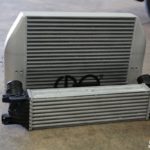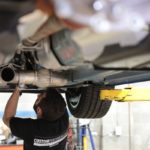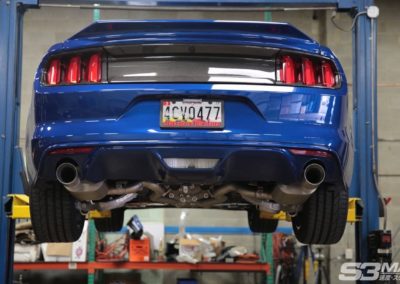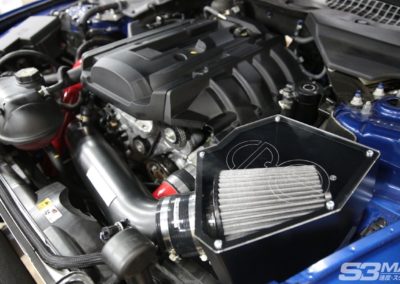Can an Ecoboost Mustang be faster than a GT? What are the best Ecoboost Mustang mods? CP-E put a bone stock Ecoboost Mustang on their dyno & went through the bolt-ons… documenting power gains at each step of the way.
The Background…
-CP-E (cp-e.com) was founded in 2003 by two engineering students at the University of MD engineering school.
-All of CP-E’s products are designed & manufactured in the USA, in Beltsville MD.
-90% of the platforms CP-E works with are turbocharged, direct injection vehicles.
The Plan…
-Take a stock Ford Ecoboost Mustang, and see what it does with full bolt ons: intake, exhaust, intercooler, and tune.
-All runs are done in 4th gear on our in-house Mustang MD500 AWD dyno. 4th gear runs take a long time & simulate high stress, allowing us maximum data-sampling, and yielding the best simulation of real world conditions.
-For baselines & comparisons, all runs were done with stock and COBB OTS (off-the-shelf) tunes. CP-E finished-off with a custom dyno tune by our in house calibrator, Mitchell Levy.
The Parts…
-COBB Accessport V3
-CP-E intake with Synoid filter
-CP-E Delta Core Stage-2 race intercooler
-CP-E Qckspl downpipe
-CP-E Hotcharge charge pipe
-CP-E Exhale cold-side charge pipe with Tial Q BOV
-CP-E Austenite 3″ mid exhaust system
-CP-E Austenite axleback exhaust
-93 octane pump gas
The Baseline Numbers…
Stock – the car put down 221whp and 261wtq.
With nothing but the COBB Accessport & COBB Stage-1 tune, it jumped to 230hp and 301wtq.



INTAKE
-The CP-E intake features a full 4″ aluminum mandrel bent tube going directly into the turbo – the only of its kind. The tube is fed by a stainless steel airbox with a plexiglass viewing panel. The box is mostly sealed, and is fed by the factory intake ducting coming from the front grill instead of the hot engine bay air. The intake box uses a 4″ oiled filter (dry filter also available). The airbox reuses the stock airbox mounting points & rubber grommets for OEM quality fit/finish.
-The results from the CP-E intake combined with the COBB OTS Stage-1 tune were very pleasing. Up 24whp and 43wtq from stock on the COBB OTS Stage-1 tune.
New numbers = 245whp and 304wtq.
The combination of the cold-air feed and the large pipe allow very little restriction on the turbo.
-Meanwhile, back to the stock tune (no COBB tune), the CP-E intake caused the ECU to ‘see too much air coming into the system’, and closed the throttle. This is a safety feature of the Ecoboost engines – which necessitates a tune, in order to keep the throttle open.
-After reviewing the datalogs from the COBB-tuned run, the charge-air temperatures reached 173 degrees F, which caused it to pull a lot of timing & boost to protect the motor. The solution?? …Intercooler.
INTERCOOLER & CHARGE PIPES
-The stock intercooler on the Mustang is small. While it does okay on the stock tune, once we try and push more boost, especially in the high RPMs, the temperatures rise rapidly. With the new giant intercooler, this all changed.
-CP-E offers two intercoolers, and several charge pipe options for the Mustang. For these tests, we used our Stage-2 race intercooler. This is one of the biggest cores on the market, at 21″x17″x3.75″ or 1339 cubic inches. For comparison, the stock intercooler is 5.5″x20,6″x3,25″ or 368 cubic inches. This means our race intercooler has a 3.6 times larger core than stock! The smaller CP-E stock-fitment intercooler would have worked just fine for this test & allowed us to keep the grill shutters, but the owner of the car wanted to leave room for future upgrades.
This Stage-2 intercooler is 100% bolt-on. No cutting, drilling or permanent modification is needed. The intercooler fits with stock charge pipes, as well as aftermarket charge pipes. And it also has cast end-tanks with a very unique feature: If the customer wants to use larger charge pipes, they can simply cut the intercooler outlets, and STILL have full bead-rolled 3″ intercooler inlets and outlets. This is a feature unique to the CP-E race intercooler. Furthermore, with the casting process, we are able to incorporate internal diffusers. These diffusers make sure that the air reaches the whole core, minimizing turbulence and pressure loss while increasing cooling performance. With this system, the customer can use the stock turbo withOUT turbo lag issues… but can also be ready/prepared for larger turbo upgrades in the future.
-CP-E has several charge pipe options. The Ecoboost Mustang has the factory electronically controlled bypass-valve located on the hot-side charge pipe. We offer a factory replacement hardpipe, with a factory BPV mounting option. But for this build, we used the normal HOTcharge pipe, as we located the new blow-off-valve on the cold-side charge pipe. CP-E offers 3 different cold-side charge pipes. The Exhale options offer both Tial Q and HKS SSQV options as well as the METHcharge, with no BOV flange. All three options have built-in meth ports allowing the customer to add a meth injection system if desired. All hardware is included to block-off the factory bypass-valve & run a manifold vacuum line to the blow-off-valve.
We did several tests with the new intercooler, to compare the charge-air temperatures. The intercooler was able to pick up 30whp and 11wtq with zero tuning changes!
New numbers = 275whp and 315wtq.
The stock intercooler was really holding it back! Compared to the peak of 173 degrees of the stock intercooler, the new CP-E intercooler kept the peak temperature down at 90 degrees. Keep in mind, it was 83 degrees in the shop! We also loaded the COBB Stage-2 tune as well, which is made to optimize a larger intercooler. It picked up a few more HP here.
We then went back and loaded the stock tune – just to see if there was any difference with the bigger intercooler on a totally stock tune. Even with the throttle being closed most of the run (due to the aftermarket intake), the car picked up 10hp in the top-end vs the stock baseline. This shows that even if you don’t plan on tuning the car, the intercooler is still a worthwhile investment for efficiency, cooling, and power.
TURBOBACK EXHAUST
-The CP-E turboback exhaust is made to work interchangeably with stock. Meaning – you can run the downpipe with the stock exhaust, or the midpipe with the stock downpipe. The downpipe comes with adapters for both 3″ catbacks AND the stock 2.5″ catback. We understand not all customers are buying a full turboback exhaust system at once so this lets the exhaust grow with the car.
-The turboback is made of 100% 304 stainless steel, mandrel bent piping, hand tig welded with CP-E’s custom mufflers and laser engraved 4″ tips, and titan finish. The downpipe is offered catless, OR with a high-flow catalytic converter. The downpipe ditches the factory 2.5″ doughnut gasket for a 3″ flat gasket. Because – why use a 3″ downpipe if it has a 2.5″ entrance?!
It’s hard to describe the sound of an exhaust with words, but ‘radical’ would be a good start. ‘Spool’ would be another. You can hear the turbo the way it is meant to be heard. The exhaust is loud when you’re on the throttle, and silent when your cruising. It’s a perfect daily driver exhaust, so long as your neighboors don’t mind the cold start.
We weren’t expecting much in terms of performance from the catback, as the stock exhaust is not very restrictive. The downpipe DOES help the turbo spool faster, so we were expecting (and received) some low end torque gains. On the dyno, we saw a modest 5whp and 5wtq gain.
At this point we’re at 291hp and 347wtq.
Most people would be happy there… with a 70whp gain and almost 90wtq! Furthermore – the car makes all sorts of cool new noises, from the intake to the BOV, and the mean roar of the exhaust.
The final tune reached 309whp and 379wtq... an overall Gain of 88whp and 118wtq.
CUSTOM TUNE
-We realize that the COBB OTS tunes are really only a base, and are meant for COBB products. This put CP-E’s calibrator, Mitch, up to the plate. If there’s more (safe & reliable) power left on the table, Mitch will find it. With the Mustang back on the dyno, and with COBB’s Accesstuner software, Mitch went to work. Before the tuning process, the car was running about 22 psi of boost peak, which tapered down as the RPM’s went up. Mitch wanted to keep the boost safe and steady while optimizing the calibration, fuel mixture, and timing.
With the same ~22psi of boost, the final tune reached 309whp and 379wtq.
A gain of 18hp and 32ft-lbs of torque over the OTS tune. This was also a conservative tune, that would let the owner use it everyday without risk of damage.
Overall Gains: 88whp and 118wtq.
CP-E tends to look at the numbers in terms of ‘percent gain’, as it’s a more comparable number. This nets a 40% jump in HP and a 45% gain in torque.
With full bolt on’s you can see that the Ecoboost makes similar numbers to its big-brother Coyote (dynoed at 360/350 on our dyno).
2017 Mustang Ecoboost with Performance Pack (3.55 gears, sway bars, suspension upgrades, brakes, gauges)
Other Modifications:
-Anderson Composites Type ST carbon fiber decklid
-Relocated license plate
-In track pictures: 19″ Fifteen52 R43 wheels








































With lithium Increased serum lithium levels and symptoms of lithium toxicity have been reported in patients receiving ACE inhibitors during therapy with lithium can i buy augmentin online